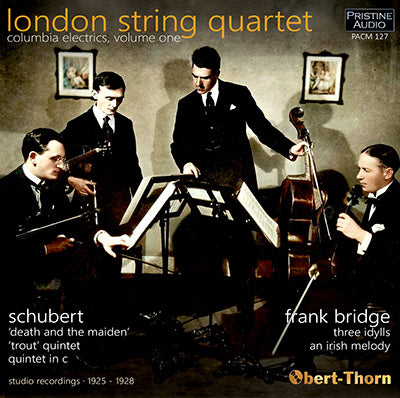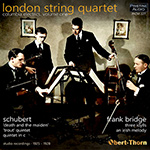
This album is included in the following sets:
This set contains the following albums:
- Producer's Note
- Full Track Listing
- Cover Art
As the Budapest Quartet would later do, and in contrast with ensembles dominated by a single famous virtuoso, the group took an egalitarian approach. As Warner recalled in 1922, “From the beginning, we have always held that there should be no ‘boss’ in the Quartet. We have always been on equal footing. If anyone disagrees with a tempo here or a phrasing there he speaks out. The point is discussed, and the decision made, if necessary, by voting.” Over the next few years, the LSQ distinguished themselves in the UK, playing the works of both standard repertoire composers as well as new music, including Schoenberg’s Verklärte Nacht, whose British première was given by the group in 1914, and works dedicated to them by Vaughan Williams and Ethel Smyth.
The coming of the Great War led to the departures of Petre (temporarily, for active duty) and Sammons (permanently, ultimately to pursue a solo career). James Levey, a Ferdinand Hill pupil, was invited to fill the leader’s position, where he stayed for the next decade. During the 1920s, the group expanded their touring schedule to include regular appearances in North and South America as well as other European capitals. Levey left at the end of the 1926-27 season, and William Primrose, then performing as a violinist, put himself forth as a candidate for his replacement. His time to join the group would eventually come (in 1930, as a violist); but the leader position now went to John Pennington, a protégé of Sir Dan Godfrey who had previously led his own quartet, and who would stay for the remainder of the ensemble’s existence.
The recordings presented in this first volume focus on this transitional period, with the last made by the Levey-led ensemble (all of the group’s 1925 electrics) bookending several 1927-28 tracks featuring Pennington. While the group was shut out of English Columbia’s Beethoven Centenary releases of 1927 in favor of the Léner Quartet (which recorded a complete Beethoven quartet cycle, available on Pristine), they were approached to record several works for the Schubert Centenary of 1928, including the Quartettsatz, the “Trout” Quintet and the Cello Quintet. Due to their touring schedule, the latter two were recorded in American Columbia’s New York studios. The accompanying players on these were Irish-born pianist Ethel Hobday, American bassist Robert Cherwin and Belgian-born, Paris-trained cellist Horace Britt, at the time a member of the Elman Quartet.
The London’s approach was similar to other groups of the period like the Léners, the early Budapest Quartet and the Flonzaley Quartet (with which they were frequently compared, particularly in their American appearances), with flexible tempi and frequent, though not overdone, use of string portamenti. While their intonation and ensemble playing was occasionally not up to the virtuoso standards that later developed under such groups as the 1930s iteration of the Budapest Quartet, their warm, old-world ambiance in the standard repertoire, as well as their passionate advocacy of new music (played with such intensity in the two Bridge works) make their performances still worth hearing a century after they were recorded.
The sources for the present transfers were prewar American Columbia copies, primarily “Viva-Tonal” pressings, except for the “Londonderry Air”, which was only issued on English Columbia.
Mark Obert-Thorn
LONDON STRING QUARTET Columbia Electrics, Volume 1
CD 1 (67:02)
SCHUBERT String Quartet No. 14 in D minor, D.810 “Death and the Maiden”
1 1st Mvt.: Allegro (11:45)
2 2nd Mvt.: Andante con moto (8:54)
3 3rd Mvt.: Scherzo: Allegro molto (3:27)
4 4th Mvt.: Presto (8:38)
Recorded 20 November and 24 December 1925 in the Columbia Petty France Studios, London
Matrix nos.: WAX 1152-2, 1153-2, 1154-2, 1227-1, 1228-1, 1155-1, 1229-2, 1230-2
First issued on Columbia (UK) L 1751/4
SCHUBERT Piano Quintet in A major, D.667 “Trout”
5 1st Mvt.: Allegro vivace (9:07)
6 2nd Mvt.: Andante (7:01)
7 3rd Mvt.: Scherzo: Presto (3:42)
8 4th Mvt.: Andantino – Allegretto (7:12)
9 5th Mvt.: Allegro giusto (7:11)
Ethel Hobday (piano) · Robert Cherwin (double bass)
Recorded 9 – 11 January 1928 in the Columbia Studios, New York City
Matrix nos.: W 98432-2, 98433-3, 98434-2, 98437-2, 98438-1, 98439-1, 98443-3, 98444-1 & 98445-3
First issued on Columbia (USA) 67401/5-D in Set 84
CD 2 (72:44)
1 SCHUBERT String Quartet No. 12 in C minor, D.703, “Quartettsatz” (7:56)
Recorded 4 November 1927 in the Columbia Petty France Studios, London
Matrix nos.: WAX 3048-6 & 3049-5
First issued on Columbia (UK) L 1679R
SCHUBERT String Quintet in C major, D.956
2 1st Mvt.: Allegro ma non troppo (14:25)
3 2nd Mvt.: Adagio (12:24)
4 3rd Mvt.: Scherzo: Presto (7:47)
5 4th Mvt.: Allegretto (8:55)
Horace Britt (cello 2)
Recorded 18 – 19 April 1928 in the Columbia Studios, New York City
Matrix nos.: W 98521-2, 98522-2, 98523-1, 98524-2, 98519-2, 98525-2, 98526-2, 98527-2, 98528-2, 98529-2, 98530-2 & 98531-3
First issued as Columbia (USA) 67448/53-D in Set 95
FRANK BRIDGE Three Idylls, H.67
6 I. Adagio molto espressivo (7:20)
7 II. Allegretto poco lento (2:18)
8 III. Allegro con moto (3:43)
Recorded 3 November 1925 in the Columbia Petty France Studios, London
Matrix nos.: WAX 1098-3, 1099-5, 1123-2 & 1124-1
First issued on Columbia (UK) L 1704/5
9 FRANK BRIDGE An Irish Melody, “The Londonderry Air” H.86 (7:50)
Recorded 17 November 1925 in the Columbia Petty France Studios, London
Matrix nos.: WAX 1096-4 & 1097-1
First issued on Columbia (UK) L 1716
THE LONDON STRING QUARTET
James Levey (1925 recordings) or John Pennington (violin I)
Thomas W. Petre (violin II)*
Harry Waldo Warner (viola)
Charles Warwick Evans (cello)
*Note that Petre does not play in the “Trout” Quintet
Producer and Audio Restoration Engineer: Mark Obert-Thorn
Special thanks to Nathan Brown, Andrew Hallifax, Jolyon Hudson, Richard Kaplan and Charles Niss for providing source material for this release
Cover picture based on a photo of the London String Quartet in 1925 (L to R: James Levey, H. Waldo Warner, C. Warwick Evans, Thomas Petre)
Total duration: 2hr 19:46

